“Mom, I Can’t Go to School: I Don’t Have a PLASTIC Water Bottle!”
I swear I’m not making this up. No sooner had I finished my post about the Top Ten Green School Projects to tackle, and fallen into bed when my newly minted third grader hit me with this zinger.
It seems stainless steel water bottles are noisy. Really. When little hands drop stainless steel water bottles from their desks, apparently they make quite a din. So my son’s teacher, on the first day of school, banned anything other than plastic water bottles.
That’s a problem for us.
After much experimentation with everything from re-used Honest Tea glass bottles to Sigg water bottles, I finally switched the family over to stainless steel water bottles. I even shelled out $20 for insulated stainless steel water bottles.
I looked and looked and looked and realized we just have no more plastic water bottles. As an ode to my bloggy friend Beth of Fake Plastic Fish, the nation’s top anti-plastics blogger, I had banned plastic water bottles from the house!
My son was very concerned.
“I can’t go to school! I need a plastic water bottle!”
“We don’t have any! You’ll have to take the stainless steel. I’ll write a note to the teacher,” I responded.
“No,” he insisted. “It HAS to be plastic. The stainless ones make too much noise; they fall from the desks.”
“Well, we got rid of all the plastic water bottles and I’m not buying any more,” I retorted. “Can’t you just get up and use the water fountain?”
“NO!!!,” he shrieked. “We can’t just get up and get a drink of water whenever we feel like it. We only get breaks like only every two hours. And I won’t get to drink until lunch time. And it’s TOO LONG!!!,” he exhaled in a burst of eight-year-old whininess.
Now I thought about just letting this go. I’ve recovered from Green Mom Culture Shock. I understand that not everything will be a Green Nirvana, not even at a Montgomery County, Maryland Green School.
I hate being THAT MOM. Yes, I’ve been called a “piece of work.”
But as I’ve blogged before, you can either sit behind your laptop and bemoan the state of the world, or you can do something.
So I wrote an email to his teacher.
Dear Ms. X:
I hope you are enjoying a wonderful start to the school year. I very much look forward to meeting you at Back to School Night.
My son informed me this morning that he needed a plastic water bottle rather than the stainless steel one he brought to class. As part of our family’s commitment to protecting and preserving the environment and our family’s health, we have reduced our use of plastics, including plastic water bottles. We no longer own any plastic water bottles – part of an expensive, time consuming process to switch from plastic to stainless steel, glass, and other more eco-friendly alternatives.
I respectfully ask you to reconsider requiring plastic water bottles for the following reasons:
1) many plastic bottles leach harmful chemicals which can disrupt the endocrine system of young children. Plastic #3 (polyvinyl chloride/PVC can leach hormone-disrupting chemicals into the liquids they are storing and will release synthetic carcinogens into the environment when incinerated. Plastic #6 (polystyrene/PS), leaches styrene, a probable human carcinogen, into food and drinks as well;
2) the plastic nib at the top of most plastic water bottles is easily scratched by young teeth, resulting in ingestion of plastic chemicals (as opposed to most stainless steel bottles, which contain an open spout for drinking);
3) stainless steel bottles, like the one I purchased for my son, can be insulated to keep water cooler longer;
4) the production of plastics accounts for about 8% of our usage of fossil fuels (petroleum, oil, natural gas);
5) it would be expensive, wasteful and time consuming for the class to replace their existing water bottles with plastic. My son told me that all but about two of the students came to school with stainless or other bottles made of materials other than plastic (likely for the reasons cited above).
I understand there is a noise issue that is causing you to request plastic bottles rather than water. Could I help you to brainstorm other solutions? Perhaps the stainless water bottles could be labeled, put in a blanket and left in a wagon near the door. I recall that approach being used for lunch bags in my son’s classroom last year.
I’m so sorry to have our first communication be about this issue. As you can tell, I am very passionate about environmental issues! I am happy to help you as you look at other classroom issues and their impact on the environment – I know from experience that switching from conventional methods to greener, more environmentally friendly practices can be a long process, requiring lots of trade-offs and education.
Thanks so much for your consideration.
Regards,
Lynn
Yikes. Where do you think this will lead? And actually, I spoke too soon. I’m experiencing Green Mom Culture Shock all over again.
How’s back-to-school going in your world? I’m thinking of updating that post about “Top 10 Green Projects” to make it “Top 20 Green Projects.”
— Lynn
Copyright 2010 OrganicMania
Filed under Green Kids, Green moms, Green Schools | Wordpress Comments (21) |The Top 10 Things I Loved About BlogHer
I had a great time at Blogher. Some people in my circles asked why, given all the controversy about the Nestle sponsorship and the excessive, sometimes reckless consumption which marred BlogHer ’09.
So here’s why. Here’s a list of the Top 10 Things I Loved About BlogHer.
- It’s the only time I get to see my tribe: the members of the Green Moms Carnival and the many other bloggers whose work I respect so much. I tweeted that I was up “partying” with The Smart Mama, Condo Blues, Fake Plastic Fish, Mindful Momma, and The Soft Landing. But actually, we’re a little nerdier than that. Sure we love to party. But you can do that anytime. Looking up municipal water tables and calculating the amount of time a glass of water stays fresh before bacteria breeds? I just can’t do that with my friends at home in Bethesda!
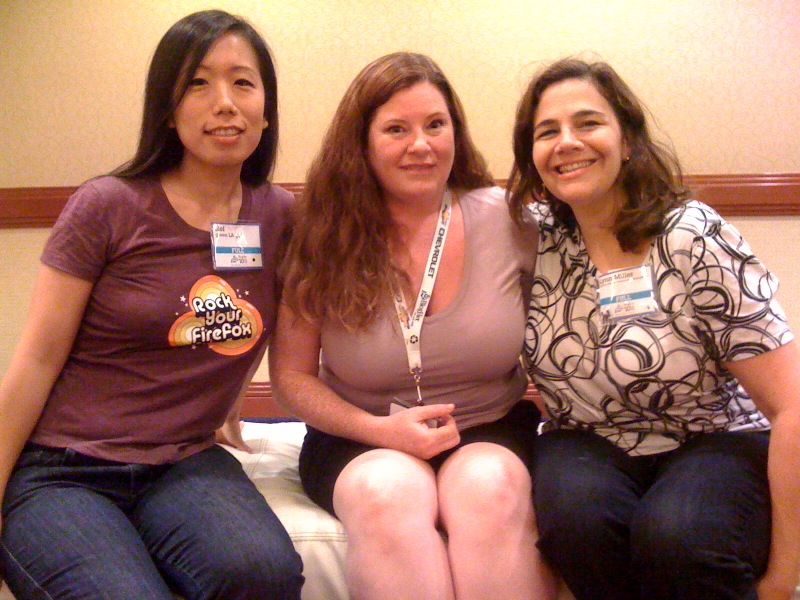 Green LA Girl Siel, left; Jennifer Taggert of The Smart Mama and Yours Truly Relaxing After a Session
Green LA Girl Siel, left; Jennifer Taggert of The Smart Mama and Yours Truly Relaxing After a Session
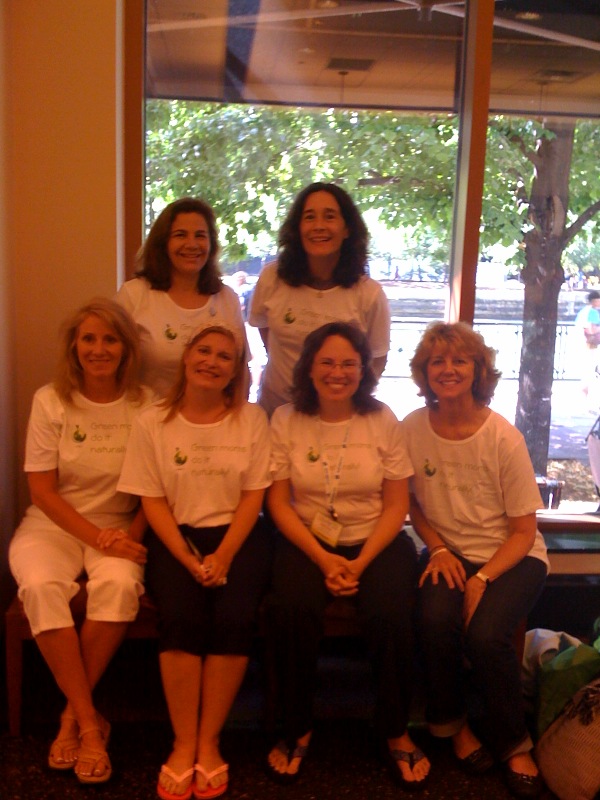
Ok, Ok, this pic was taken last year at BlogHer ’09. Can you believe we don’t have a group shot from this year?
2. I loved seeing all the women. It’s a very special experience to be at a conference for women, by women, particularly if you’ve worked in fields, like I have, where there are few women on the conference circuit.
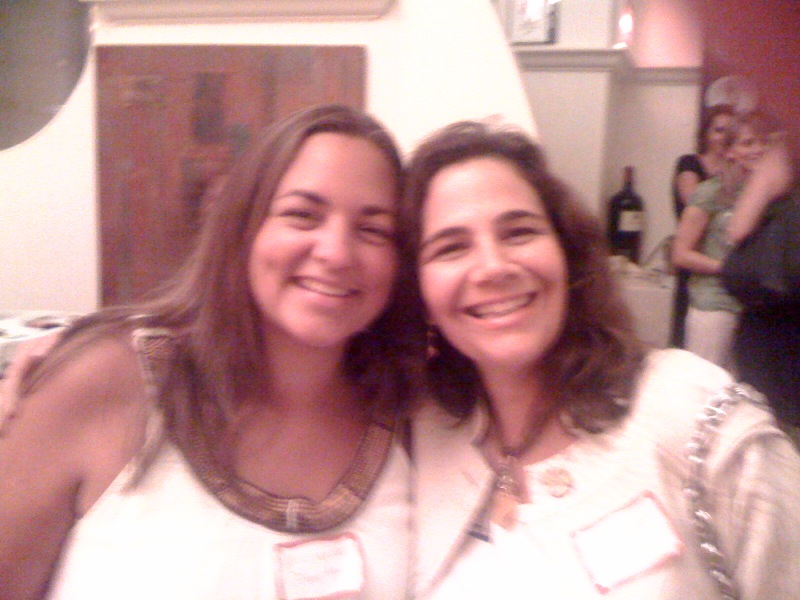 Doppelgangers? It’s been said that Alicia of The Soft Landing and I look alike. What do you think?
Doppelgangers? It’s been said that Alicia of The Soft Landing and I look alike. What do you think?
3. It was a better BlogHer than last year from a sustainability perspective. Would I call it a Green Conference? Or even say, “BlogHer Goes Green?” Uh….no. But it was a huge step in the right direction. And I’ll have more to say on that in my next post.
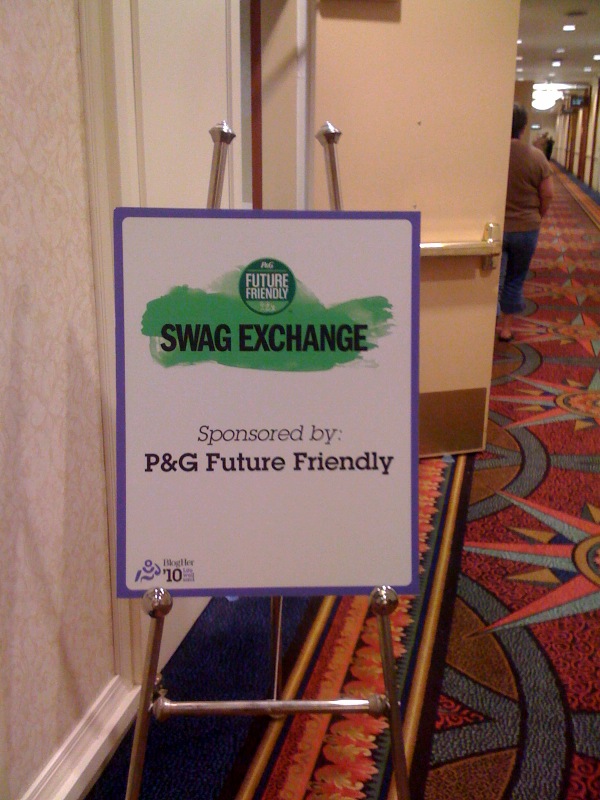
4. Great speakers. My favorite this year was the ending keynote. When I listened to the beautiful 70-year old Marie Wilson of The White House Project and Take Our Daughters and Sons to Work Day, I was inspired. Her vitality made me think, “Wow, I’ve only just begun. I’m not so old after all. I have a lot yet to do and to give.”
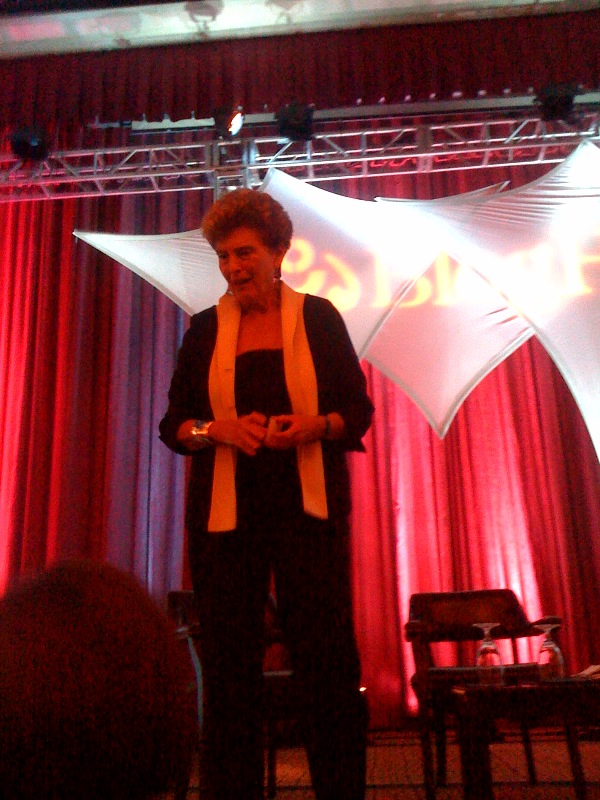
6. Great dancing. The dance floor rocked. How often do most of us get out dancing? Uh…never. (Except for my recent college reunion!)
7. Pampering.
8. Never being asked to stop tweeting.
9. Interesting people. The opportunity to strike up conversations is right in front of you all the time. Every woman there has a story. What’s hers?
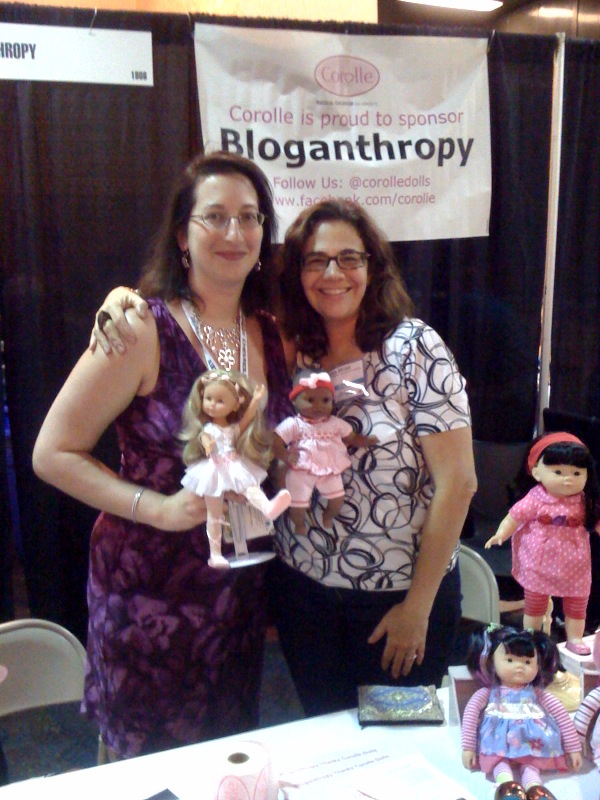 With Debbie Bookstaber, co-founder of Bloganthropy. (Thank you, Corolle dolls for your sponsorship of Bloganthropy!)
With Debbie Bookstaber, co-founder of Bloganthropy. (Thank you, Corolle dolls for your sponsorship of Bloganthropy!)
10. Wonderful venues. New York, of course, was amazing. So was Chicago last year (my first BlogHer conference). And next year, BlogHer ’11 will be in San Diego. I’ll be there. Will you?

— Lynn
Copyright 2010
Filed under Blog, Green moms, Tips | Wordpress Comments (11) |
@GreenMoms Take On Cosmetics: Safe or Unsafe? And Should We Support the Safe Cosmetics Act?: It’s the Green Moms Carnival!
We’ve got a wonderful round-up of posts from members of the Green Moms Carnival, women who have been following the debate about cosmetics ingredients for years, and have interesting stories to share.
Let’s start off with Diane MacEachern of Big Green Purse. Diane blogs “evidence is emerging that the cumulative use of these products may be contributing to asthma, the onset of puberty in girls as young as three years old, and even the feminization of baby boys. Because cosmetics, soaps and shampoos are washed down the drain, they get into our water system, where they’re wreaking havoc on wildlife. And what about their relationship to breast cancer?”
But Diane doesn’t leave us hanging – she gives three common-sense ways we can reduce our exposure to the potential risks of cumulative exposure to low doses of chemicals.
Beth Terry of Fake Plastic Fish tells the story of why she tried to get away from a cute seat mate on a recent flight. “His Axe cologne, or whatever heinous product he was wearing, made my eyes water, nose itch, throat close up, and left me with a throbbing headache.”
That’s something I’ve experienced as well. Once you stop using synthetic fragrances, it’s hard to even be around them. A walk down a grocery store aisle – or a whiff of last year’s BlogHer room drops – can leave you feeling miserable.
Lisa from Condo Blues recounts an interesting discussion with a research scientist from a personal care company.
“One of the biggest secrets about what chemicals (or not) is in a product is what makes up the product’s fragrance,” she notes. “Last summer, I had the chance to talk to a representative from a large personal care company. She claimed that even her company didn’t know what was in the fragrances of their products because they buy the fragrance from a special fragrance house that has a super secret formula and ironclad nondisclosure agreement that says the fragrance house won’t tell the company what’s in the signature scent of their brand of shampoo.”
Katy at Non-Toxic Kids makes a case for showing The Story of Cosmetics to friends who may be unfamiliar with the battle for safer cosmetics. As she puts it, “Why should you care? There is a growing body of research showing links between many of the chemicals in our personal care products and serious diseases and conditions. Chemicals like triclosan, phthalates, parabens are in most cosmetics. Phthalates are often labeled as “fragrance”. Triclosan is labeled as an “antibacterial.”
And no one is looking at their synergistic effect on our bodies, especially those who are developing and growing at rapid rates: our children. The companies who make these products are using many chemicals that have never been independently tested for safety. That’s right, never.”
Linda from Citizen Green presents a well researched post that follows-up on Katy’s assertion. As Linda blogs, “Only 11 percent of the 10,500 ingredients in personal care products have been assessed for safety by the cosmetics industry.”
And that’s the reason Deanna of Crunchy Chicken blogs, “Make sure you start checking your product labels!”
Karen of Best of Mother Earth pulls no punches when she asks, “How can cosmetic companies like Estee Lauder raise funds for cancer research and produce products with carcinogens in them? Shouldn’t they start in their own back yard and produce a safe cosmetic in the first place?”
I always especially enjoy the contributions of our Carnival members from outside the United States. In Amber’s post at Strocel.com, Story of Cosmetics: Canadian Edition, she blogs about the situation in Canada – how in some ways it parallels the situation in the US, and yet how there are subtle differences. For example, Canadian cosmetic makers are required to list ingredients – “but not all of them.” Huh? So what good does that do? But Amber’s main message is one that is universal:
“But we must recognize that the beauty industry is trying to sell us stuff, just like any other industry that markets consumer goods. They want us to believe that we are flawed and need their stuff. If we aren’t concerned about the state of our skin or the shininess of our hair, we’re not going to shell out for products to fix them. Even initiatives like the Dove Movement are marketing campaigns aimed to make us feel favourable towards a certain brand.
My daughter Hannah is 5 years old. I don’t want her to feel that she needs to coat herself with stuff to be OK, and I especially don’t want the stuff she coats herself with to contain toxins. That’s why I want to see change in the cosmetics industry.”
I always see myself in Micaela’s (aka Mindful Momma’s) posts. Maybe it’s because we have kids around the same age, and while we are passionately committed to living sustainably, too often our lives intersect with the real world of Toys R Us and Pokemon.
In her post, “Maybe I Just Bought the Wrong Stuff,” Micaela blogs, “In The Story of Cosmetics, Annie Leonard comes out and says what a lot of us might be thinking when it comes to buying cosmetics and personal care products: “maybe it’s my fault…maybe I just bought the wrong thing”…meaning it’s our own damn fault for buying personal care products loaded with toxins and petroleum products…because we didn’t take the time to research the hell out of them before we went to the store.
I’m telling you – that is often how I feel. And it’s very frustrating.”
Frustrating? Lisa from Retro Housewife Goes Green goes even farther when she blogs, “I don’t know about you but I’m pissed off at the amount of work I have to do to keep myself and my family safe from cancer causing chemicals. We need to change the whole system and work together to demand safer cosmetics.”
I’m with Lisa – the whole system needs to change, and in my opinion, that includes regulation. But I’m not so sure the Safe Cosmetics Act is the answer. Check my post out here, where I blog about what I’ve learned in two years of following these issues – the things people inside the industry have told me – and my surprise and concern about the backlash opposition to the Safe Cosmetics Act that is being led by small, independent cosmetics makers.
Jennifer Taggert of The Smart Mama (and an attorney) voices her concern that the Safe Cosmetics Act may mean for small businesses. Jennifer has a unique take on this, and her full post is worth a close read. Here’s an excerpt:
“I bring the CPSIA up after watching The Story of Cosmetics because well intentioned legislation can go badly wrong.
That doesn’t mean that I don’t urge you to understand what it is you are buying. To adopt the precautionary principle in your purchasing decisions.
That doesn’t mean that I don’t think we should advocate for sensible legislation and regulations.
But that’s it – the legislation and/or regulations must be sensible. And that is hard to do. The devil is in the details. Overbroad legislation has unintended consequences and collateral damage.
As said by Supreme Court Justice Louis Brandeis:
The greatest dangers to liberty lurk in insidious encroachment by men of zeal, well-meaning but without understanding.”
What do you think?
Leave a comment and let us know!
And did you know you can get ALL of our posts pushed out to you via Twitter? Just follow us here: http://www.twitter.com/GreenMoms
— Lynn
Copyright 2010 OrganicMania
A Day In The Life: When Advocating for Green Is Easier Than Being Green
I was amused last week when I saw these tweets from a California conference. “Green is Mainstream.” “It’s not a differentiator.” “It’s just what everyone does.”
Really? Maybe I need another trip to California. (But of course, that wouldn’t be too green.)
For this month’s Green Moms’ Carnival, Beth of Fake Plastic Fish challenged the Green Moms to write about a “Day in the Life,” reflecting on the “green steps we take as well as the green challenges we face and the hard decisions we have to make.”
As luck would have it, I chose a day that ended up revealing a sad truth: sometimes it’s easier to advocate for green than to be green. Does that make me a hypocrite? Or does it just show how much more work we have to do before being green in Maryland is as easy as being green in California?
But back to my day….It was Wednesday, June 9th, cloudy and overcast, and threatening showers as I closed the front door. I was heading out to the Bethesda Green Incubator, where my business is located. I was on time (mindful that running late invariably results in taking the car instead of walking), ready for an easy 15 minute walk.
But I hesitated.
The sky was dark. What if it rained? I had my laptop, after all. I wouldn’t want that to get soaked, would I? I debated. I thought about Beth. I thought about the Carnival. I thought about water seeping through my bag, damaging my laptop. The minutes crept away. I was on the verge of being late. I took the car. It’s not a Hybrid. It consumes oil, the very kind that’s seeping into the Gulf.
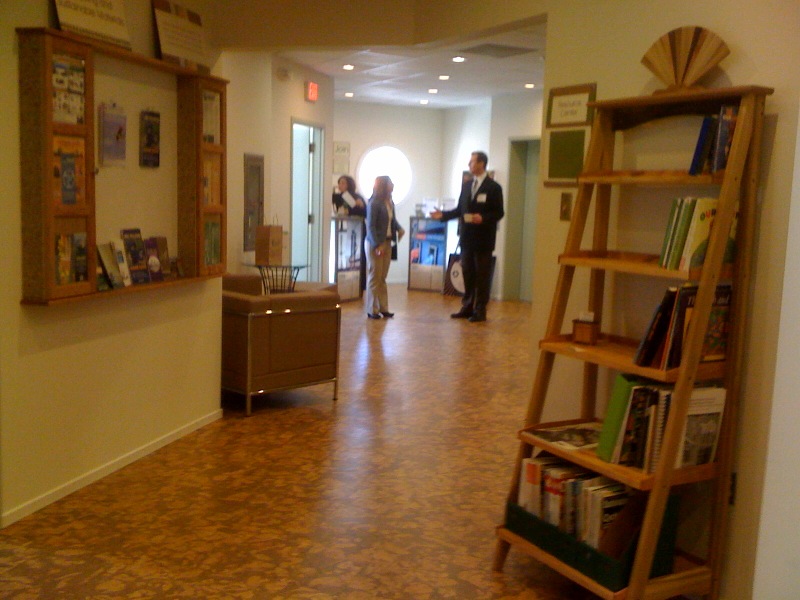
At the Incubator, I walked out to our model-green reception area to meet Ariana Kelly, a Moms Rising advocate and candidate for the Maryland State House.
I told her the Bethesda Green story: how the community came together – business, government, and residents – to take on volunteer projects to make our community more sustainable. I pointed out the cork floors, the low VoC paints, the rain barrel displays, the permaculture exhibit, specimen seed library, and solar panels.
Then we walked across the street for lunch (so far, so good) and ate a lunch that assuredly was not sustainable. (After all, when it’s sustainably raised seafood they charge more for it and advertise it as such, don’t they?) At least our conversation was green. We talked about all that Maryland was doing with B Corp legislation and the BPA ban, and the Bethesda Green Business Delegation that met in Annapolis recently.
Then I ran out to retrieve my car, soon discovering the day’s first stroke of Bad Green Karma. A parking ticket.I should have walked. Not a drop of rain fell from the sky. And now I owed $40. My lunch had suddenly became quite expensive.
Later that afternoon, I picked Boo up from preschool, wincing as he carried some Pepperidge Farm goldfish in a plastic cup out the door. Every day, I dutifully packed reusable containers. Couldn’t they be used to pack up snacks?, I wondered. Must remember to bring that up to the teachers, I thought, as I dashed out the door to my car (yet again). After all, we had to hurry to make it to the CSA pick-up, and then on to the end-of-year Cub Scout picnic.
Soon, I stood at the CSA, hurriedly weighing the fresh-picked biodynamic and organic produce. Scallions? Check. Apples? Natch. Radishes, swiss chard, kale, fresh-baked bread, lettuce, they all went into my re-usable bag.
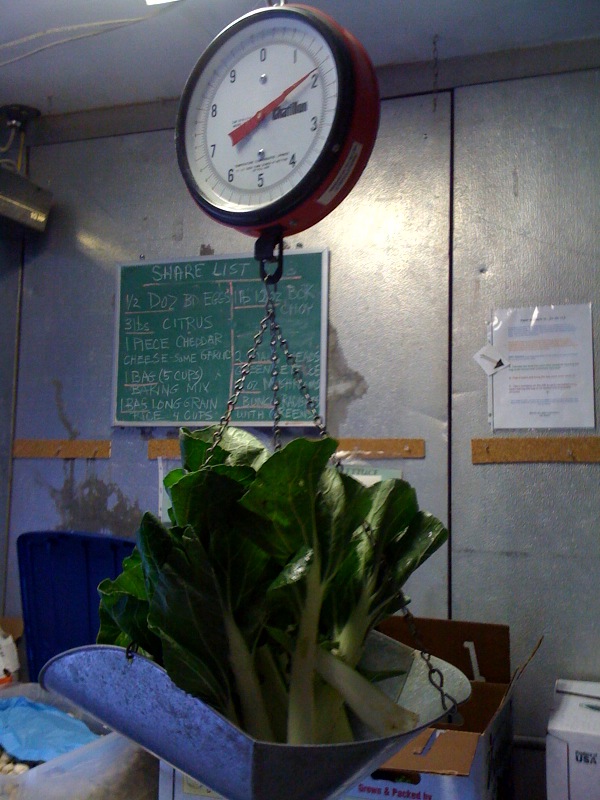
I heard Boo fussing, and asked him to be patient and wait for Mommy. I was in a hurry, after all, and there were four people behind me, waiting to use the scale.
Then I heard it.
CRASH.
Tiny bits of crushed Pepperidge Farm goldfish – all over the pristine garage floor of the CSA. Ev eryone froze, looked at Boo, and then looked at me. I sighed and said, “That’s what happens when you dare to bring Pepperidge Farm goldfish to a biodynamic CSA. God strikes you down.”
After the laughter died down, a broom appeared, everything was swept up, and we were off on our way to the picnic.
I was in such a hurry, I didn’t bother to check directions before I left the house. And my in-car navigator (Big Boy) wasn’t with me….he had left ahead of time with his friends and their Mom. So I overshot the park. Sat, idling (burning more of that fuel) in front of an apartment building 1 /4 mile from the turn-off for the park, frantically navigating my iPhone, trying to figure out where I was supposed to be.
(Maybe at this point I should mention my DH was on Day Seven of an extended business trip. The one where he gets to hang out in a castle by the Mediterranean Sea. And I was spent from playing Single Mom for a week).
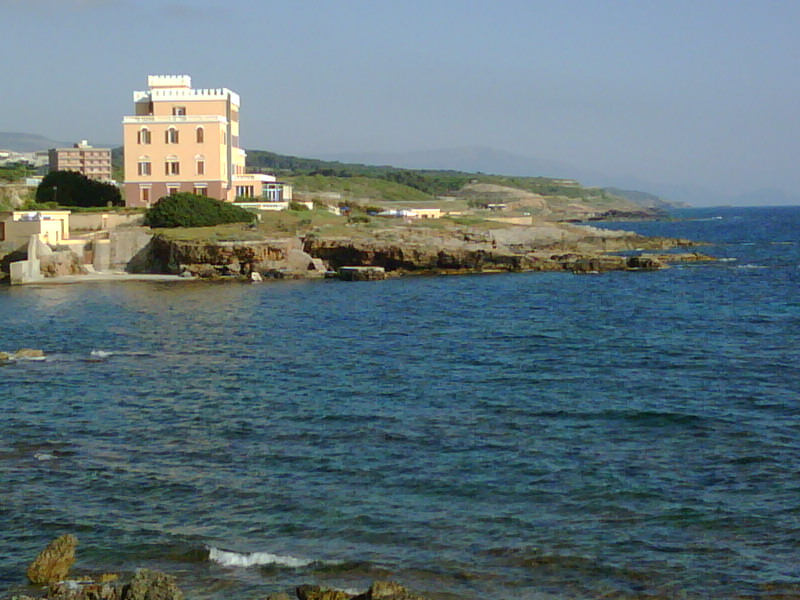
Finally, we arrived at the picnic, eager to partake in the festivities. I frowned at the hot dogs and hamburgers, thinking of the heavy burden conventional farming techniques, especially those used to rear cattle and pork, place on our ecosystem. I helped myself to some salad, trying to ignore Boo’s pleas for a hotdog or hamburger, before finally giving in. Their father, the committed vegetarian, was out of town. And we so rarely had meat. They even had a grill! I ended up eating some myself.
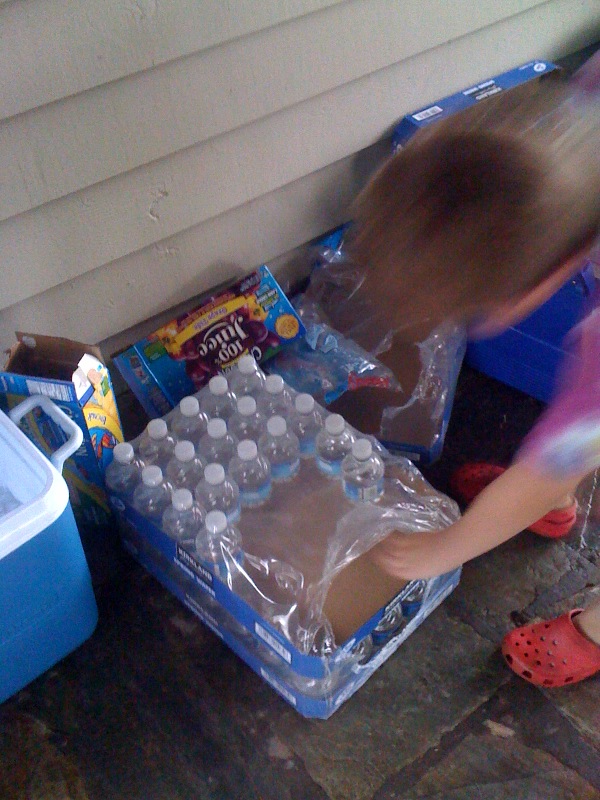
But the bottled water? That was just beyond the pale. I hurried out to my car to retrieve my stainless steel water bottle. At least I had remembered that! When I returned, my friend smirked and asked me to look closely at the bottled water. They weren’t drinking water, she said.
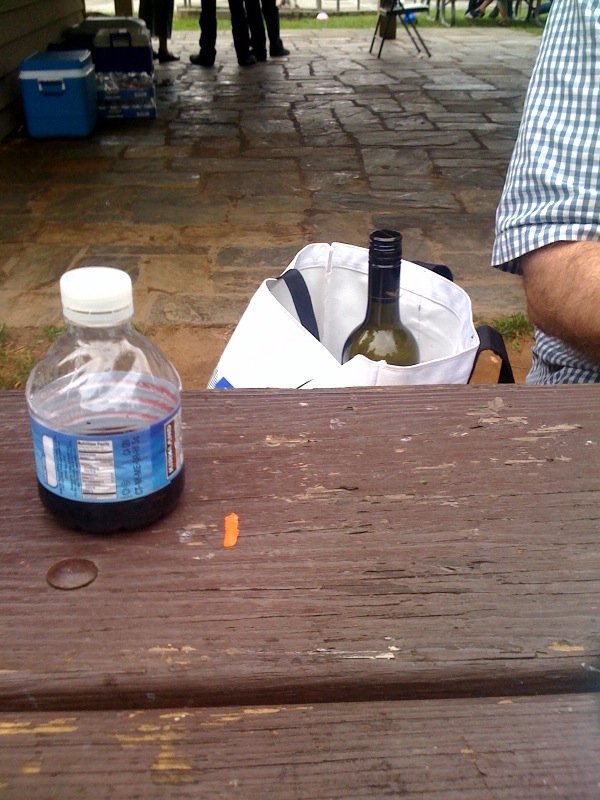
I burst out laughing. Cub Scout parents surreptitiously drinking wine from empty water bottles? It brought back memories of alcohol snuck into parties when I was under-age. It was too funny. I had to have some! (Just on general principle!) But how? I only had my water bottle, and Boo needed some water. My not-so-green friend eyed me, amusedly. She knew exactly the calculation I was making.
“I’m not touching those plastic bottles!” I hissed.
I asked Boo if he wanted some more water.
“No, I’m fine,” he told me.
“Drink up, “ I urged. “There won’t be any more water.”
“I’M FINE!!!”
I dumped the rest of the water out of my re-usable water bottle and smiled contentedly as her husband filled it part way with the red wine. It wasn’t that good, actually, but it was the absurdity of the situation that made it worthwhile.

“Mama, can I have some more water?”
That’s when I gave up and opened one of those darn plastic water bottles.
(And made a mental note to see if we couldn’t procure some large water jugs for the next Cub Scout picnic.)
And decided that I had more than enough material for a decent “Day in the Life” post.
Easy to be green? Maybe in California. But not where I live.
What about you?
— Lynn
Copyright OrganicMania 2010
Filed under Bethesda, CSAs, Green Ideas & Stuff, Green moms, Green Moms Carnival Home Page & Calendar | Wordpress Comments (15) |A Fair Trade Halloween? Not Completely.
This Halloween, I was convinced, would be the year that fair trade Halloween chocolates made it to the mass market — or at least to Whole Foods! Sadly, #nestlefamily fiasco notwithstanding, we’ve still got long way to go before fair trade Halloween chocolates are widely available.

I started my quest in early October, pulling up the Reverse Trick or Treating website run by Global Exchange. This program distributes free Fair Trade chocolates along with educational materials about the benefits of fair trade, which include a commitment to:
* ENDING poverty among cocoa farmers
* STOPPING forced/abusive child labor in the cocoa industry and
* PROTECTING the environment
Unfortunately, they were already sold out. And my quest for Fair Trade chocolate began. My first stop was Whole Foods in DC’s Tenleytown neighborhood. No luck. Then I tried Whole Foods River Road in Bethesda, Maryland. Nada. How about Whole Foods Rockville Pike, in Rockville, Maryland? Zilch. Back to My Organic Market in Rockville, Maryland. Nothing. Trader Joes in Bethesda? No.
Why was I so determined? Ever since my friend Diane MacEachern of Big Green Purse told me that 50% of the cocoa in this country comes from Cote d’Ivoire, which still practices forced child labor on many of its cocoa plantations, I have tried to avoid conventional chocolates.
But by mid-October, I was beginning to think I’d never find Fair Trade Halloween chocolate, so I started looking for substitutes.
At Target, I found pretzels from Pennsylvania – $3.27 for a bag of 35, or just 9 cents per treat.

By now, we were a week away from Halloween, and Big Boy was bitterly complaining about only having “boring” pretzels to give out as treats to his friends. So I caved and bought some bon bons at Giant. I thought I was safe – chocolate-free – until I discovered that one of the candies – Bit-O-Honey – are made by Nestle.
Finally, at Trader Joes, I picked up 2 bags of chocolate bars – not whole trade, but from Columbia. Since the slave labor employed in the cocoa industry is focused in Africa — specifically Cote d’Ivoire – I reasoned that cocoa from somewhere other than Africa was probably the next best thing to Fair Trade cocoa. And at $2.79 per bag, or ten cents per piece, it was competitively priced to American brands.
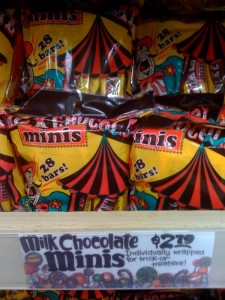
A few days before Halloween, at the Takoma-Silver Spring co-op, I found small Fair Trade chocolates – but the price — 40 cents per piece – gave me pause. My neighborhood is overrun with kids on Halloween eve, and I didn’t want to spend a hundred dollars or more on Halloween candy!
But I did leave the co-op with YUMMY EARTH USDA Organic lollypops, 70 in a bag for $2.79 or just 3 cents per piece. Made with real flavors including organic black carrot, pumpkin, black currant, and apple, these lollypops are delicious! They will definitely become a Halloween staple in our household.
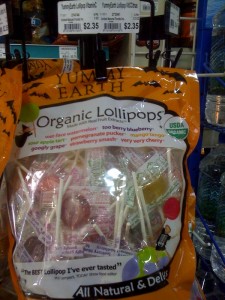
I could not believe that there was no Fair Trade Halloween chocolate to be had in DC or Bethesda, so I started sending tweets out asking for help. I heard back from Divine Chocolate, suggesting I visit a store in a far away part of DC.
In a final attempt to finish my quest, I dashed into Ten Thousand Villages near Bethesda Row and low and behold, found some Fair Trade chocolate – perfect for Halloween. At 25 cents per piece, the Divine Chocolate gold coins were about the price I expected – expensive but manageable. I picked up 2 bags of gold coins, but not before hearing the store manager say many other frustrated shoppers had been in seeking fair trade Halloween chocolate as well.
Not in my neighborhood. Surveying my son’s overflowing trick-or-treat bag, I didn’t see another organic or fair trade item. I felt a bit like I had been spitting into the ocean – a tiny drop of nothing in a sea of high fructose corn syrup, slave labor chocolate, and artificial colors and ingredients — all wrapped in plastic – reams and reams of plastic. I wondered how my Green Moms Carnival friends Jennifer (The Smart Mama), Jennifer (The Green Parent), Micaela, Beth, Maryann, Sommer, Jess, Karen, Anna, Alicia and the others had handled this holiday. Hmm…I’m thinking next year we should plan a carnival on Halloween treats!
Hope your Halloween was happy! What did you hand out? And did you go crazy looking for Fair Trade chocolates too? Leave a comment and let me know!
And at the end of the day, it’s all about these funny little faces, isn’t it?

— Lynn
Copyright 2009 OrganicMania
NOTE: Here is a link to the latest information I could find from the US chocolate industry about the continued struggle for equity in Cote d’Ivoire.
Filed under Food, Green moms, Holidays, My Organic Market, Parenting, Product Recommendations, Savings Tips, Trader Joes, Whole Foods | Wordpress Comments (13) |Walmart Knows What’s Best for Us Green Moms. Right?
As a child, my mother used to drag me out to endless open houses. It was fun to look at the gorgeous new homes for sale and to dream. But invariably, we would laugh. She’d point to a kitchen door that was too far from a countertop, or a window that was ill placed, or a closet that was too small, and say with a loud HUMPPH, “Must have been a man that designed this house. They have no idea how we women live.”
My mother’s words came back to me when I learned from my friend, the green blogger Mary Hunt of In Women We Trust that Walmart is developing its new sustainability index without ANY consumer input. What’s more, they’re charging companies $250,000 to participate in the process of setting the standards. They’re even charging to attend webinars to learn how the index works!

Pictured: Sam’s Club Fair Trade Coffee for sale at Walmart. Cheapest price I’ve ever seen for Fair Trade coffee!
Some of you might be thinking, “Who cares?” Most of my friends don’t shop at Walmart. In fact, most actively avoid the place. I recall a “Green Moms” dinner once where only two of us had even tread foot inside a Walmart. But as I’ve blogged here, here, and here, I actually do shop in Walmart from time to time, and I’ve eagerly cheered them on as they’ve stocked more fair trade, USDA organic, and eco-friendly items. After all, as Walmart goes, in large part, so goes Middle America. And this is why Walmart’s Sustainability Index is so critical to all of us.
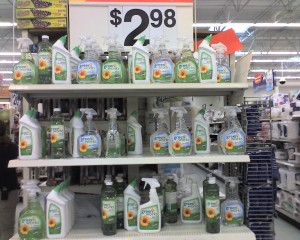
A large selection of Clorox GreenWorks products at a Walmart -- all for $2.98 per bottle.
By virtue of its sheer size, Walmart’s standards will become the de-facto standards for all products. It doesn’t matter if you’re buying at Walmart or your local corner store. If your favorite products are carried at Walmart – and this includes green favorites like Clorox GreenWorks, Horizon USDA Organic milk, most major organic jarred baby food brands, and many other household brands – your product will be designed to meet Walmart’s standards. Their standard will of necessity become our standard, because the manufacturers will (rightly so) insist that they can’t meet multiple standards. They’ll choose one standard to meet, and if Walmart insists on a Sustainability Index before the US Government mandates one, well….you can guess whose standard will become the de-facto standard of the land.
Others who pooh pooh the need for consumer input might reason, “Well, the companies know what consumers want, don’t they?” Hmm…if all companies knew what mattered most to consumers, all companies would be fabulously successful with amazing, defect-free, safe, functional products.
So Walmart, if you decide you do want consumer input, we’re happy to give it. Just don’t charge us for the privilege, please.
And to hear what other members of the Green Moms Carnival are saying about Walmart’s Sustainability Index and its impact on consumers, please check out Mary Hunt’s blog, In Women We Trust, where she hosts this month’s Green Moms Carnival on Sustainable Standards: What’s the Consumer’s Opinion?
— Lynn
Copyright 2009 OrganicMania
Update – 10/28/11 Since I wrote this post, Walmart has updated its site with links to both the Sustainability Index webinar (which you can watch for free) and a PDF of the Supplier Sustainability Index. — Lynn
Filed under Green Ideas & Stuff, Green moms, Organic Prices, Organic Product Needs, Where to Buy Organics | Wordpress Comments (14) |10 Eco-Friendly Tips for a Greener Labor Day Weekend
It’s hard to believe that Labor Day weekend is here already. The summer has flown by. So here’s wishing you a wonderful long weekend! And to keep it green, following are my top 10 tips for greening your Labor Day weekend.
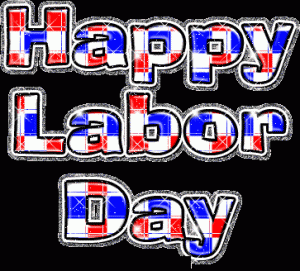
1. Just about the first thing people think about on Labor Day is firing up the grill. This year, skip the burgers and beef hot dogs. The production of beef is a major contributor to three of the four global warming gases — carbon dioxide, nitrous oxide, and methane.
2. What to grill instead? How about some grilled shrimp? If you’re at the beach, head to your local seafood shop. If you’re in my neck of the woods – MoCo near DC – check out Whole Foods fantastic sales on previously frozen wild caught raw shell-on shrimp – $6 off per pound, now just $9.99 per pound instead of $15.99 per pound. It’s delicious – and a sale that Whole Foods seems to run pretty frequently, fortunately. (And if shrimp isn’t your thing, how about pasta salad, potato salad, or organic soy-based corn dogs? Here are some other Labor Day recipe ideas).
3. Need a new grill? My favorite tips on solar-powered and other “green grills”are here. at Diane MacEachern’s Big Green Purse blog.
4. If you’re still using charcoal grills, reconsider. The prices of gas grills have dropped dramatically – I’ve seen them on sale for just $95 at KMart – and they’re a more Earth-friendly choice than charcoal. Or if you want to splurge, check out Weber gas grills. My local hardware store, Strosniders is running a big Labor day sale – they’ve got gas Weber grills from $399 up to $2599.

5. If you must use charcoal, Diane MacEachern suggests using lump charcoal instead of briquettes, which may contain coal dust
and other additives. Diane says to look for hardwood briquettes from forests certified by the Rainforest Alliance’s SmartWood program, or lumps made from coconut husks. Cow boy Charcoal, sold at Lowe’s, Trader Joe’s and under the Whole Foods 365 brand, makes chunk charcoal out of wood leftover from furniture making and construction.
6.
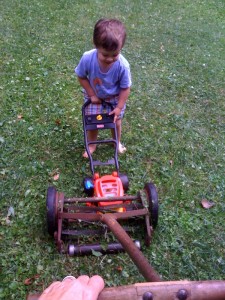
Need to mow the lawn to make your yard look beautiful? Forget about conventional gas and electric mowers. Go retro with a good old fashioned push mower. Not only will you help to save the planet, you’ll get real exercise too! If you must use gas or electric, how about sharing a mower with your neighbors? (And if your little one wants to copy you, you can borrow the neighbors’ plastic mower. Yes, both mowers in this pic are borrowed! Talk about Reduce, Reuse, Refuse!)
7.

To some folks, a party’s not a party is not a party without lights. Thankfully, there are more and more choices for LED lights, including these patriotic red, white and blue starred LEDs I found at Strosniders Hardware. (No, I didn’t buy them, but they’re cute, aren’t they?)
8. Consider recycled paper plates. I found the ones pictured above at my local Giant grocery store in Bethesda, Maryland, and I’ve also seen them at “Party City” stores. They’re priced comparable to regular paper plates. They’re cute and an eco-friendlier choice!

9. When dusk comes, and you head inside, open the windows instead of turning on the air conditioner. You’ll save money and the environment!
10. If you’re heading back home to the big city after enjoying time at the beach, you may want to check out the local farmers markets and grocers. We pick up organic and local fruits when we are in smaller towns that enjoy a lower cost of living than our big city home town.
Have a great holiday weekend!
Lynn
– Copyright 2009 OrganicMania
Labor Day Image Credit: AltiusDirectory.com
Filed under Green moms, Holidays | Wordpress Comments (3) |Green Schools: Green Moms Tell It Like It Is!
With 32 submissions from 28 green women bloggers, I am thrilled to share what may be the most comprehensive listing of environmentally friendly back-to-school tips on the web. From daycare to college to homeschooling, we’ve got you covered! And these tips are from women who’ve been there and done that: the wonderful women of the Green Moms Carnival. Thanks to all of the contributors for sharing your insights so that together, we can green those schools!
On a side note, Happy Birthday to the Carnival! It’s hard to believe, but we got started a year ago August when we launched our very first carnival, “Tackling Global Warming.”
Let’s dive in. The 32 blog posts fall into eight categories:
- At the Beginning: Green Childcare;
- Healthy Meals and How to Pack a Waste-Free Lunch;
- School Supply Lists and Eco-Friendly School Supplies;
- The Edible Schoolyard;
- Why It’s Worth Fighting to Keep Recess;
- Greening Your School: From Green Committees to Green Certification;
- Back to School: Homeschooling Edition; and
- Tips for Green College Kids.
So sit back, grab your BPA-free water bottle, and enjoy this comprehensive look at Green Schools.
At the Beginning: Green Child Care
- Jennifer McNichols of ZRecommends and The Tranquil Parent shares some great advice in her post, “Green Daycare: A five step method for getting a childcare center to support your cloth diapering.” She did it, so can you!
- Mary Hunt of In Women We Trust tells us how the Los Angeles Community College District is setting new standards for green building, which benefits the child care centers in the system. As Mary puts it, “build green, teach green, learn green, live green and bring the next generation along in your footsteps.”
Eating Healthy – What to Eat and How to Pack a Waste-Free Lunch
- Of course we all know the most important meal of the day is breakfast. Sommer from Green and Clean Mom shares some great Healthy Breakfast Ideas.
- Amy from Crunchy Domestic Goddess shares some really nifty tips for Turning Back to School Lunches Green. I especially appreciate the fact that Amy brings up the issue of over packaging, and she even includes links to great recipes!
- Green Bean from Green Phone Booth shares a wonderful story about an old cookbook, circa 1951, devoted to packing healthy, interesting, and waste-free lunches. She poses the question: So what have we really learned in 2 generations?
- Like Green Bean, Mindful Momma writes about a simpler era and then goes on to include some simply wonderful, clever tips for packing a healthy lunch. Check it out!
- Amy of Gift of Green passes along some helpful tips for how to pack a waste-free lunch in her post, “Back to School, Back to Green.”
- Kristen from GreenStyleMom puts our concerns into perspective in her post, “School Lunch Priorities.”
Those Darn School Supply Lists, Plus Eco-Friendly School Supplies: What are They? And How to Find Them
- Do you know about smencils? I hadn’t heard of them until I read Citizen Green on “Back to School Green (With as Little Plastic as Possible) about her adventures to three big box stores (Walmart, Staples and Target) to try to find environmentally friendly school supplies.
- Are you sick and tired of antibacterial soap everywhere, including on your child’s school supply list? ( I know I am!) Katie from Kitchen Stewardship issues this Bath and Body Works Anti-Antibacterial Soap Letter. Katie has made it easy to, as she puts it, “vent about the overuse of the toxic triclosan and the crazy marketing Bath and Body Works throws at us, our children, and their school administrators.” On her site you’ll also find links to information about safe hand-washing, the dangers of antibacterial soaps, and a breakdown of hand sanitizers to prepare you for the back-to-school germaphobia. (Frankly, I think I’ll pass her letter along to my school administrators in addition to Bath and Body Works. It irks me to no end that we were all but required to buy anti-bacterial cleansers for the classroom!)
- Sommer of Green and Clean Mom, in her second submission to the carnival, feels much the same as Katy does about anti-bacterial cleansers, particularly those with triclosan. In her post, “Triclosan and the Non-Toxic Classroom,” this former teacher offers some tips for dealing with the schools around this issue.
- Beth Terry of Fake Plastic Fish presents us with a conundrum: which one of these three binder options is actually more environmentally friendly? As with so much in the green movement, the choices aren’t clear-cut.
- However, as Beth points out in her second contribution to the carnival, the choice of using PVC or not is actually quite clear-cut. Beth presents a great argument against the use of PVC binders, lunchboxes, and the like, and links to more resources from the Center for Health and Environmental Justice, which has just launched a Parent’s Guide to Safer School Supplies.
- I swear, everytime I read one of EnviroMom’s postings I feel like packing it in and moving to Portland. This one is no exception, with Renee writing about a wonderful local organization that consolidates the school supply lists and donates excess to charity. She also shares some of her hits and misses in shopping for eco-friendly items for back-to-school.
Eco-Friendly School Supplies, Waste-Free Lunch Tips and More: All in One Green Tips for Back to School!
Several of the @GreenMoms shared great round-up posts with tips for green back-to-school that include everything from healthy waste-free lunches to eco-friendly school supplies, to clothing, walking instead of riding, and more!
- Just when we’ve figured out what BPA is and what all those plastic # signs mean, we’ve got another strange substance to become familiar with: Microban. Read all about it here courtesy of Jennifer Taggert, the SmartMama.
- MC Milker from Not Quite Crunchy Parent includes Five Ways to Go Green for Back To School, including a wry look at her own version of “carbon offsets.”
- Tiffany from Nature Moms gives great tips on Eco Friendly lunch boxes and water bottles, including reviews of some of her favorites, as well as helpful tips for clothing, backpacks, and other school supplies that are kind to the environment.
- In “Going Back to School Green,” Leslie from Recycle Your Day shares her memories of how she prepped for back to school – back in the days when recycled paper was gray and cheaper than conventional paper! Plus, she shares plenty of more-up-to-date tips with us, including reviews of a few favorite products.
- And if you’re not sure your kid can master the art of returning bottles and containers, Diane of Big Green Purse has a “secret tip” for you, in addition to some great background information on why environmentally-friendly lunch boxes are so important. Check out “Lunch Boxes Should Be Safe and Environmentally Friendly” and learn about some of Diane’s favorite eco-friendly options!
- If you find that some of these eco-friendly lunch kits simply cost more than you’re willing to spend, check out “How to Pack a Cheap and Easy Waste-Free Lunch” where I share some of my favorite frugal green tips, from $1.99 for a big pack of recyclable brown bags to el-cheapo reusbale food containers.
School Supplies: End-of-Year Disposal Issues and a Quest for More Sustainable School Supplies
- In her post, “School Supplies are Environmentally Frustrating,” Anna Hackman of Green-Talk includes photos documenting how she laboriously disposes of school binders at the end of each school year. Inspired by both the Jumpstart Conference and by Beth Terry’s successful Take Back the Filter Campaign, Anna begins a quest to have Avery Dennison incorporate her feedback into their sustainable product development process.
The Edible Schoolyard: Kindergarten Edition
- Deanna from Crunchy Chicken shares “The Edible Schoolyard,” an encouraging tale of how a kindergarten class started an edible garden at her local elementary school.
Why It’s Worth Fighting to Keep Recess
- In “Recess Helps Kids Learn, Don’t Take It Away!” Katy Farber of Non-Toxic Kids shares her insights about why it’s important to keep recess a priority in the schools. One would think that the research on the benefits of healthy recess would be well understood by educators, but unfortunately it’s still not a priority in our nation’s schools.
Greening Your School: From Green Committees to LEED Certification, & Asbestos Abatement
- Tiffany from Mommy Goes Green shares “My Healthy School” – some great tips for working with your school administration to green your school.
- Yours truly (OrganicMania) shares five lessons learned trying to get a Green Committee off the ground at an elementary school.
- Melissa from Raising Them Green shares An Introduction to the LEED for Schools Rating System. I didn’t know that there was a special LEED certification just for schools, did you?
- The bloggy world is so crazy – I had to go to BlogHer to meet Jennifer from Puddle Jumping in DC – who just submitted a wonderful post about a certified green school, right here in Montgomery County, Maryland, where I live! I had no idea! Check out Jennifer’s post, which includes a wonderful video of a 5th grade girl discussing what it’s like to study at a green school.
- Jennifer, our Smart Mama, provides a heads-up about early warning signs of asbestos exposure in your school and provides us with some simple steps to reduce asbestos exposure.
Back to School: HomeSchooling Edition
- Of course, it’s dilemmas like the fight for recess that Katy described in her post that are pushing more and more parents to private schools and to homeschooling. Lisa Sharp doesn’t have kids of her own, but she was homeschooled and she shares some wonderful memories and tips for Green home schooling parents in her post, “Back to School: Home Schooling Edition.”
Tips for Green College Kids
- We’ve run the gamut from daycare to college. The kids have grown up, but we parents are still concerned with keeping ep them healthy and safe. Karen Hanrahan of Best of Mother Earth shares her tips for helpful herbal remedies for how to Keep Your College Kid Healthy.
- Lisa of Condo Blues shares ten tips for college students who want to go green. My favorite? Donate unused clothing, furniture, food, etc. before leaving campus.
About the Green Moms Carnival – We are a group of green women bloggers, united by our desire to protect and preserve Mother Earth. Once a month or so, we share our thoughts on a common theme, so that together our environmental messages are heard by more people than we could possibly ever reach on our own. You can read more about us here and you can subscribe to all our blog posts automatically through Twitter at @GreenMoms.
— Lynn
Filed under Green moms, Green Schools, Parenting, Product Recommendations, Savings Tips, School lunches, Tips | Wordpress Comments (20) |Green Schools: Five Lessons Learned the Hard Way
Editor’s Note: This post is for the Green Moms Carnival on Green Schools, which will appear here at OrganicMania on Tuesday, August 11th. There will be great contributions from green women bloggers from all around the country, weighing in on green schools – from nursery school to college!
It seems like just yesterday that I squeezed into a seat at the kid-size cafeteria tables at my son’s new elementary school. I was there to participate in my very first PTA meeting, and while I was interested in many of the things going on at the school, what I really wanted to learn about were the school’s environmental initiatives. I wanted to get involved in the Green Committee.
Imagine my surprise when the PTA leadership didn’t seem to understand what I was talking about. They invited me to become involved with the committee that watered the trees over the summer. Oh, and they really wanted some help with a children’s garden.
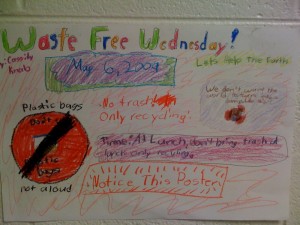
But I’m not much of a gardener. I may feel green, but my plants are brown. I wanted to focus on environmental issues like substituting conventional school cleaning products with more environmentally friendly options; introducing waste-free lunches; eliminating the throw-away styrofoam trays used in our lunchroom; replacing Sally Foster fundraisers with more eco-friendly options; and stopping the Cheap Plastic Crap giveaways used at school fundraisers. And that was just for starters! Then I could see moving on to including walkable schools in our County and State Carbon Reduction Programs, retrofitting the school with solar or wind power, and more…
I think the other committee members went into overload just listening to my wish list. Our principal suggested that the new parents hold back and watch and learn what went on at the school instead of jumping in with a million new directions. So I did what comes unnaturally to this Jersey girl: I shut my mouth.
After the meeting, several other of the incoming parents approached me and said they understood and supported what I was proposing, and would be glad to help. The problem was that no one wanted to lead the effort. No one could seem to find the time. I agreed to co-chair a committee, but soon found that coordinating with a co-chair and getting the committee off the ground fell by the wayside as I focused more of my energy on work, home, family, other volunteer work, OrganicMania, and the Green Moms Carnival.
I blogged a bit about my Green Mom Culture Shock during this time and how I was Dealing with the Schools: Coping as a Green Mom…but then I went all quiet on you. Didn’t say too much about what was going on…
So did we make progress this last school year? Yes, but not nearly as much as I would have liked. I did learn a few lessons, though, which I’m happy to share with other eager parents as they seek to navigate the new world of PTAs and public schools. What about you? What’s worked for you? Please leave a message and share, because the new school year is about to start up and we can all learn from each others’ experiences. What’s worked for you as you’ve sought to green your school?
Lesson #1: Meet People Where They Are
Only months after that first meeting did I learn that the existing gardening committee had plenty of “greenies” involved who would have been happy to take on many of the other issues I proposed. And had I volunteered first with that committee, proved myself, and learned how things worked at the school, our Green Committee probably would have had more impact.
Lesson #2 Get Support from Area Non-Profits
Through the Green Schools committee of my town’s sustainable communities initiative, Bethesda Green, I learned that the Audobon Society’s Green Schools Initiative was trying to reduce waste at my son’s school. Several of the other committee members were from my son’s school, and we were encouraged us to go back and try again with the Green Committee, or just to do things on our own as we could fit them in. The woman who led the charge? Probably the busiest one among us – she has triplets!
Lesson #3 Seek out Liked Minded Allies in the School Early On
Through the Green Schools committee, I met a teacher from my son’s school. She was able to shed some light on mysteries like WHY the class buying lists contained so many plastic items, and how to get that changed for the next school year.
She was also able to explain that there were a bunch of different Green initiatives going on at school that would have more reach and impact if they were coordinated. Coincidentally, I heard the same thing from the PTA president at that time. Soon we were able to get things a bit better organized, and on much sounder footing for this coming school year.
Having friends “on the inside” of the school really helps!
Lesson #4 Connect with other Local Schools and Learn What’s Worked There
Some of the other schools here in Bethesda, Maryland have had far greater participation in their “Waste-Free Wednesday” lunch campaigns than we did with ours. It may just take time for new ideas to take root, but it would have been ideal if we could have touched base with the green leaders at our town’s other schools to see how they achieved so much success. Thanks to our community-wide Green Schools initiative, we’ll be connecting with those other green school leaders soon.
Lesson #5 Propose Well Thought-Out Alternatives
It’s not enough to say, “Get rid of the traditional school fundraising programs and all of the “stuff” that they push on people!” When well established fund raising programs are bringing in $20K or so for the PTA, you’ve got to have a plan to replace that money. There are many new green school fundraising programs emerging, but how much money are schools actually making from these programs? That’s one question I haven’t yet been able to answer to our PTA’s satisfaction. (Perhaps a kind reader will leave a comment here with that information!)
What about you? What’s worked and what hasn’t worked as you’ve sought to “green” your neighborhood schools? Please leave comment and share!
Lynn
Copyright OrganicMania 2009
Filed under Bethesda, Green Charities, Green Ideas & Stuff, Green moms, Green Moms Carnival Home Page & Calendar, Green Schools, School lunches, Tips | Wordpress Comments (12) |How to Pack A Cheap and Easy Waste-Free Lunch
There are many eco-friendly options available for school lunch, but let’s face it: most of them are still pretty pricey. Shelling out $21 for a Sigg water bottle or $37.95 for a Laptop lunch box adds up to big bucks quickly.
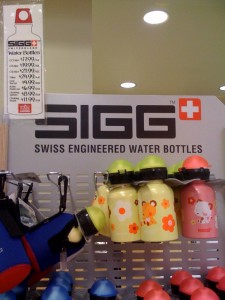
The very popular Sigg bottles range in price from $17.99 to $24.99 at this Bethesda Whole Foods.
Here are five super cheap, easy ways you can send your kids back-to-school with an eco-friendly lunch bag. If you’re fortunate enough to have what you need already, maybe you could take this post and send it to a school list serv or to others who might find this information helpful.
There are really just five things you need for a waste-free lunch:
1. Lunch box – or brown bag. While there are great eco-friendly lunch box options out there, most range from $14 on up. You can buy a pack of 100 brown paper lunch bags for $1.99. No, it’s not totally waste-free, but most municipalities recycle paper – so you can toss the bag out with the newspapers to be recycled! It’s a much more environmentally friendly option than buying a conventional school lunch bag, which are often made of PVC plastic. Read here to learn why you want to avoid PVC, which is harmful to our health and to the environment.
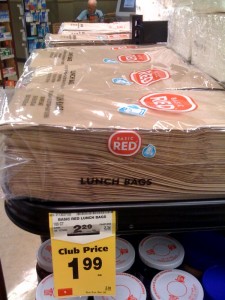
As seen in a Bethesda Safeway, buy 2 packages for $3.98 and you'll have enough recyclable brown bags for the entire school year.
2. Water bottles. This is a biggie. Visit nearly any school cafeteria and you’ll see a staggering amount of waste from disposable juice boxes and milk containers. Yet most stainless or non-PVC water bottles are $10 and up – some as high as $25 or more. Before I invested in two Sigg Mr. Sharky’s (pictured below), I used a good ole Honest Tea bottle. Made of durable glass, it was fine for drinks on the go. I still use one in a pinch!
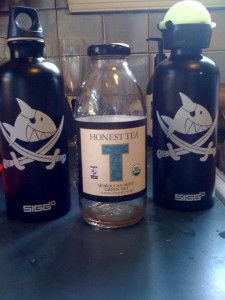
A durable glass bottle, such as this Honest Tea bottle, can be reused as an on-the-go water bottle.
3. Cloth napkin. No need to buy new here. Pretty much everyone has a spare dish rag or dish towel lying around the house, or some “good” cloth napkins that are only taken out for “special occasions.” These are perfect for school lunch. So far, my son hasn’t asked why he carries a linen dishcloth with a 1977 calendar on it, but I’m sure that day is coming soon…!
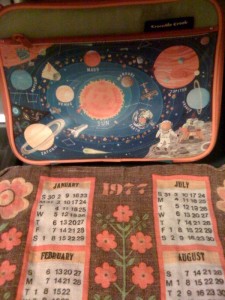
Yes, that's my mother's calendar dish towel from 1977, now doubling as a napkin in my son's lunch box. Do I get a Reduce, Reuse, Recycle, Refuse award for this?
4. Food containers. My how things have changed just in the past year. Now you can buy stainless steel containers for school lunch. But again, cost is an issue. If you don’t want to spend $40 for an all-in-one lunch kit or $16 for a stainless steel food container, you can go the el cheapo route like I did.
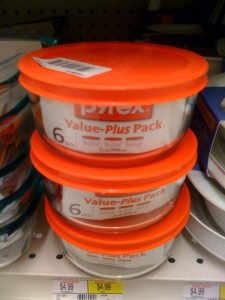
Three of these glass Pyrex food storage units sell for just $4.99 at a Bethesda Giant Food store.
Unfortunately there are no more of these nifty $4.99 glass pyrex containers at the Bethesda Giant, because I bought out their entire stock!
And here’s a shot of Big Boy with his lunch bag, which contains some plastic (gasp) Gerber food containers. I love these. They’re made in the good old USA, they’re cheap (under $5 for 4 small dishes) and they’re made of #5 plastic, which does not contain BPA. Still, to be on the safe side (because all plastics can leach) I keep these plastic bowls out of the dishwasher and the microwave I had to search high and low for these – they seem to sell out as soon as they’re in stock, but you can sometimes find them at Target or Buy Buy Baby.
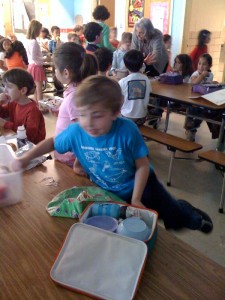
He’s also carrying a more traditional “Green Mom” accoutrement – a Wrap n’ Mat sandwich wrap, which is made of washable cloth and durable, low density polyethylene (LDPE). These sell for $7.99 on the Internet, but I bought mine locally at My Organic Market. When I hit the Wrap n’ Mat website as I was writing this post, I learned that they’ve just introduced little snack pouches, which sell for $8.99 each.
5. Cutlery. This past school year I packed lunches with our regular cutlery, and unfortunately I regret it because some of our silverware never made it home. This year I’m trying Sporks !
And I leave you with a picture of my boys’ trusty Crocodile Creek lunch bags being cleaned out. Because this frugal green Mom isn’t planning to buy new ones this year!
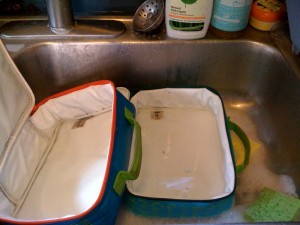
This post is for the Green Moms Carnival: Green Schools Edition, which runs tomorrow (Monday, August 10th) right here at OrganicMania.
— Copyright 2009 OrganicMania
Filed under Bethesda, Food, Giant, Green moms, Green Schools, My Organic Market, Product Recommendations, Savings Tips, School lunches, Sustainable Packaging, Tips, Whole Foods | Wordpress Comments (13) |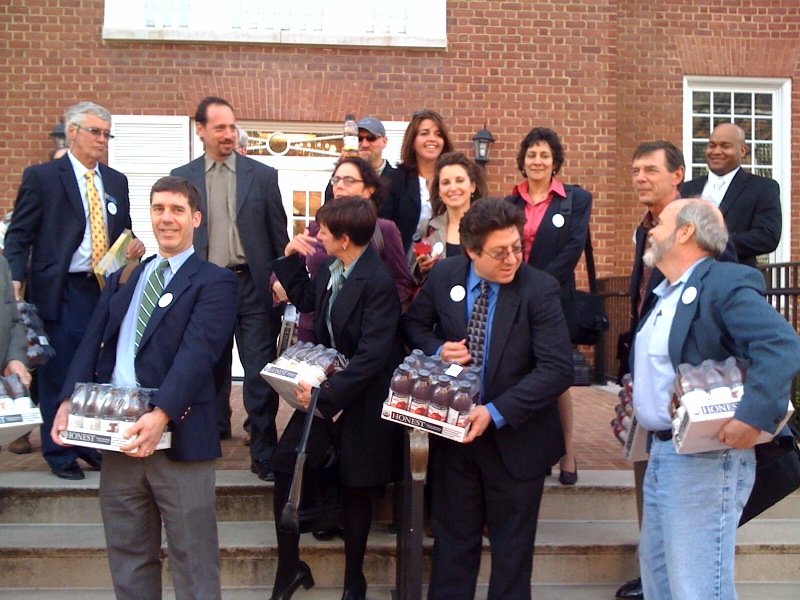
 My StumbleUpon Page
My StumbleUpon Page



